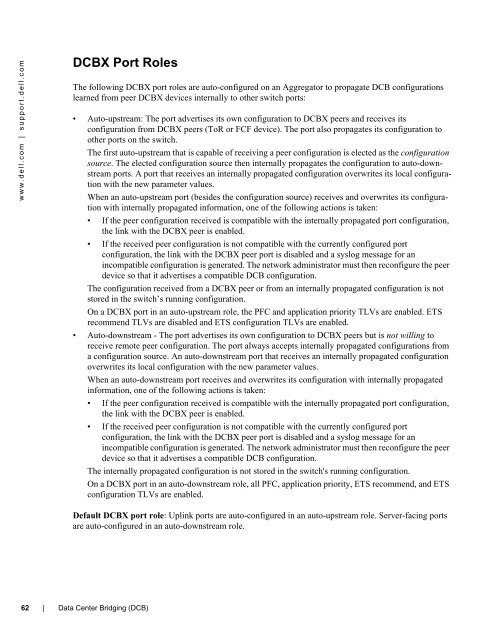8.3.17.0 - Force10 Networks
8.3.17.0 - Force10 Networks
8.3.17.0 - Force10 Networks
Create successful ePaper yourself
Turn your PDF publications into a flip-book with our unique Google optimized e-Paper software.
www.dell.com | support.dell.com<br />
DCBX Port Roles<br />
The following DCBX port roles are auto-configured on an Aggregator to propagate DCB configurations<br />
learned from peer DCBX devices internally to other switch ports:<br />
• Auto-upstream: The port advertises its own configuration to DCBX peers and receives its<br />
configuration from DCBX peers (ToR or FCF device). The port also propagates its configuration to<br />
other ports on the switch.<br />
The first auto-upstream that is capable of receiving a peer configuration is elected as the configuration<br />
source. The elected configuration source then internally propagates the configuration to auto-downstream<br />
ports. A port that receives an internally propagated configuration overwrites its local configuration<br />
with the new parameter values.<br />
When an auto-upstream port (besides the configuration source) receives and overwrites its configuration<br />
with internally propagated information, one of the following actions is taken:<br />
• If the peer configuration received is compatible with the internally propagated port configuration,<br />
the link with the DCBX peer is enabled.<br />
• If the received peer configuration is not compatible with the currently configured port<br />
configuration, the link with the DCBX peer port is disabled and a syslog message for an<br />
incompatible configuration is generated. The network administrator must then reconfigure the peer<br />
device so that it advertises a compatible DCB configuration.<br />
The configuration received from a DCBX peer or from an internally propagated configuration is not<br />
stored in the switch’s running configuration.<br />
On a DCBX port in an auto-upstream role, the PFC and application priority TLVs are enabled. ETS<br />
recommend TLVs are disabled and ETS configuration TLVs are enabled.<br />
• Auto-downstream - The port advertises its own configuration to DCBX peers but is not willing to<br />
receive remote peer configuration. The port always accepts internally propagated configurations from<br />
a configuration source. An auto-downstream port that receives an internally propagated configuration<br />
overwrites its local configuration with the new parameter values.<br />
When an auto-downstream port receives and overwrites its configuration with internally propagated<br />
information, one of the following actions is taken:<br />
• If the peer configuration received is compatible with the internally propagated port configuration,<br />
the link with the DCBX peer is enabled.<br />
• If the received peer configuration is not compatible with the currently configured port<br />
configuration, the link with the DCBX peer port is disabled and a syslog message for an<br />
incompatible configuration is generated. The network administrator must then reconfigure the peer<br />
device so that it advertises a compatible DCB configuration.<br />
The internally propagated configuration is not stored in the switch's running configuration.<br />
On a DCBX port in an auto-downstream role, all PFC, application priority, ETS recommend, and ETS<br />
configuration TLVs are enabled.<br />
Default DCBX port role: Uplink ports are auto-configured in an auto-upstream role. Server-facing ports<br />
are auto-configured in an auto-downstream role.<br />
62 | Data Center Bridging (DCB)
















